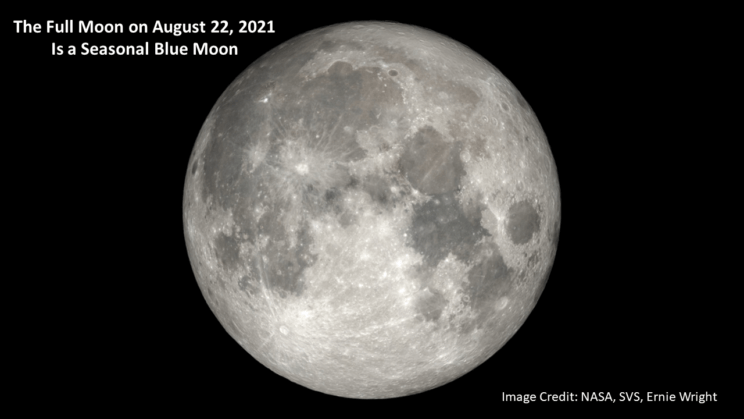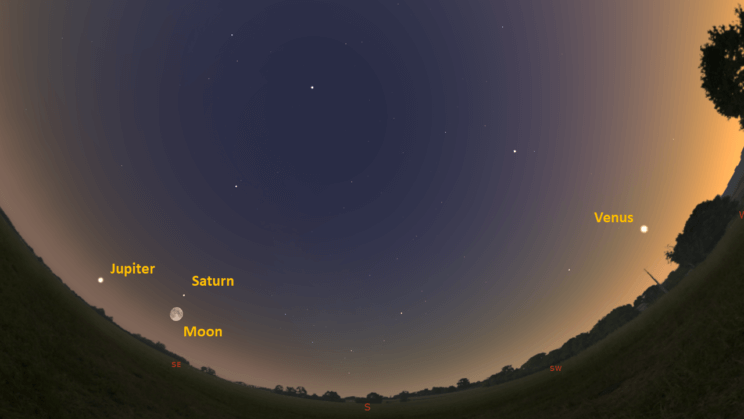This is the Saint Louis Science Center’s NIGHT SKY UPDATE for the week of Friday, August 20, 2021.
Information updated weekly or as needed.
Times given as local St. Louis time, which is Central Daylight Time (CDT). For definitions of terminology used in the night sky update, click the highlighted text. If relying on times posted in Universal Time (UT), St. Louis is -5 hours when CDT.
Public Telescope Viewings
With the changing recommendations from the CDC regarding COVID-19, conversations regarding the return of star parties at the Saint Louis Science Center have begun. We are close to bringing back our public telescope viewings, but a few details still need to be worked out. We will post future updates as we learn more about when we can bring back telescope viewings.
Observing Highlight of the Week

On August 22,2021, Full Moon Occurs. This Full Moon is also a Seasonal Blue Moon.
Image Credit: NASA, SVS, Ernie Wright
This week, the Moon reaches full moon on August 22, 2021, at 7:02 a.m. By the time we see the Moon rise on this date, it will be exhibiting a waning gibbous phase with only 99% of the lunar disk illuminated. Due to this we can see the Moon closest to full moon as it is setting on August 22, 2021, at 5:04 a.m. The full moon for August 2021 is also called a Blue Moon.
The full moon in August will not look blue. The term “blue moon” instead relates to the number of full moons each calendar year. The Moon completes its cycle of phases (synodic month) every 29.5 days, so usually there is one full moon every month. Using this 29.5-day cycle, September’s full moon occurs on September 20, 2021, at 6:55 p.m. Once our ancestors discovered this predictability of the moon phases, they learned to keep time with its cyclic behavior. You may have noticed that full moons are often given names such as the “Thunder Moon” in July or the “Snow Moon” in February. These names were often used to reflect conditions occurring in the world around us.
Another name you may have heard is the Harvest Moon. This name is given to the full moon closest to the Autumnal Equinox, which occurs anywhere from two weeks before or after the equinox. Essentially the Harvest Moon is either the last full moon of summer or the first full moon of autumn. In 2021, it is the last full moon of summer making it the fourth full moon of the season. Depending on the date of full moon, we can experience four full moons in one season. This occurs every 2 to 3 years. When there are four full moons in one season, the third full moon is called a Blue Moon. Therefore, the full moon on August 22, 2021, is a Blue Moon.
Once calendars shifted to being based on the Sun and the cycle of seasons, the moon phase cycle as a measure of time became complicated. The modern Gregorian calendar is a close approximation of the time it takes for the Sun to return to the same position in the sky based to the cycle of the seasons. This cycle of the Sun’s apparent motion is called a tropical year. During a tropical year, there are 12.4 synodic months. Therefore, the moon phases do not occur on the same dates each month. In the 5th century BCE, a Greek named Meton found that 235 synodic months is approximately the same length as 19 tropical years. This relationship of 235 synodic months being roughly the same as 19 tropical years is called the Metonic Cycle.
Even though there is a discrepancy between synodic months and one tropical year, we still divide the year into twelve lunar cycles or months. Because of this, a month will periodically have two full moons, the second of which is also called a blue moon. This is possible because the synodic month is about one day shorter than the average calendar month. Like seasonal blue moons, monthly blue moons occur every 2 to 3 years. The last monthly blue moon occurred on October 31, 2020, and the next one will occur on August 21, 2023.
To wrap up this week’s exploration of the Moon, and its synodic cycle, we should mention that it is possible to have a month with no full moons. This can only happen in February, and it occurs in years that have two full moons in both January and March. This last occurred in 2018 and will occur again in 2037; interesting, 19 years apart.
The Sun and Moon

The Moon as seen from the International Space Station, on July 31, 2011.
Credit: NASA
Sunrise is at 6:20 a.m. on Friday, August 20 and sunset is at 7:48 p.m. providing us with roughly 13.5 hours of daylight. Even after sunset, the light from the Sun will dimly illuminate our sky for roughly 1 hour and 30 minutes. This period is called twilight, which ends around 9:25 p.m. this week. For those with a sundial, local noon occurs around 1:03 p.m. this week.
| Day | Sunrise | Sunset |
|---|---|---|
| 2021-08-20 | 6:20 a.m. | 7:48 p.m. |
| 2021-08-21 | 6:20 a.m. | 7:46 p.m. |
| 2021-08-22 | 6:21 a.m. | 7:45 p.m. |
| 2021-08-23 | 6:22 a.m. | 7:44 p.m. |
| 2021-08-24 | 6:23 a.m. | 7:42 p.m. |
| 2021-08-25 | 6:24 a.m. | 7:41 p.m. |
| 2021-08-26 | 6:25 a.m. | 7:39 p.m. |
| 2021-08-27 | 6:26 a.m. | 7:38 p.m. |
| 2021-08-28 | 6:27 a.m. | 7:36 p.m. |
Moon
Moonrise for Friday, August 20 occurs at 7:11 p.m. and moonset will occur at 5:04 a.m. on the following day. On Friday, August 20 the Moon will exhibit a waxing gibbous phase with about 97% of the lunar disk illuminated. Full moon occurs on August 22, 2021, at 7:05 a.m. The full moon for August 2021 is the third of four full moons this summer making it a blue moon.
International Space Station (ISS) Observing

Visible passes of ISS from St. Louis for the week of August 20 occur during morning hours. The best passes this week occur on the mornings of August 23 and 26. Use the table below for information about these and other visible passes this week.
Catch ISS from St. Louis starting Friday, August 20
| Date | Starts | Max. altitude | Ends | |||||||
|---|---|---|---|---|---|---|---|---|---|---|
| Time | Alt. | Az. | Time | Alt. | Az. | Time | Alt. | Az. | ||
| 21 Aug | -1.3 | 05:50:43 | 10 | S | 05:53:12 | 19 | SE | 05:55:42 | 10 | E |
| 23 Aug | -3.4 | 05:51:43 | 10 | SW | 05:55:02 | 64 | SE | 05:58:23 | 10 | ENE |
| 24 Aug | -2.5 | 05:05:50 | 19 | S | 05:07:44 | 34 | SE | 05:10:50 | 10 | ENE |
| 25 Aug | -1.6 | 04:20:38 | 20 | SE | 04:20:38 | 20 | SE | 04:23:01 | 10 | E |
| 25 Aug | -3 | 05:53:53 | 10 | WSW | 05:57:06 | 41 | NNW | 06:00:19 | 10 | NE |
| 26 Aug | -3.7 | 05:08:20 | 33 | WSW | 05:09:40 | 70 | NW | 05:13:02 | 10 | NE |
| 27 Aug | -2.9 | 04:22:58 | 49 | E | 04:22:58 | 49 | E | 04:25:39 | 10 | ENE |
| 27 Aug | -1.8 | 05:56:51 | 10 | WNW | 05:59:23 | 19 | NNW | 06:01:55 | 10 | NNE |
| 28 Aug | -0.6 | 03:37:34 | 13 | ENE | 03:37:34 | 13 | ENE | 03:38:05 | 10 | ENE |
| 28 Aug | -2.3 | 05:10:32 | 21 | WNW | 05:11:50 | 27 | NNW | 05:14:46 | 10 | NNE |
Magnitude (Mag): The Measure of brightness for a celestial object. The lower the value is, the brighter the object will be.
Altitude (Alt): The angle of a celestial object measured upwards from the observer’s horizon.
Azimuth (Az): The direction of a celestial object, measured clockwise from an observer’s location with north being 0°, east being 90°, south being 180° and west being 270°.
For information about ISS flyovers and other visible satellites, visit www.heavens-above.com
Detailed information regarding all unmanned exploration of our universe, missions past, present, and planned, can be found at Jet Propulsion Laboratories:
The Visible Planets

Looking South, at 8:15 p.m. August 20, 2021
Credit: Stellarium, EG

Looking South, at 3:00 am, August 21, 2021
Credit: Stellarium, EG
This week, three naked eye planets are visible. Venus be found in the west after sunset. Jupiter and Saturn can be found in the southeast by 10:00 p.m. Soon Mercury will join us in the evening sky as it is starting an evening apparition that will be visible most of September 2021.
Venus
Venus is well into another evening apparition. Venus should be visible about 15 to 20 minutes after sunset. Look to the west about 14° above the horizon but make sure the Sun has set. Venus sets at 9:28 p.m. As 2021 continues, Venus will continue to elongate from the Sun until October 29 when it reaches maximum eastern elongation. After this date Venus will start to head back towards the Sun as it approaches inferior conjunction on January 8, 2022.
Jupiter
Jupiter has passed opposition and as such will be visible about 30 minutes after sunset. Look for Jupiter in the southeast as it starts to darken outside. Jupiter sets at 6:14 a.m. tomorrow morning and will set about 30 minutes earlier each week. Jupiter reaches superior conjunction on March 5, 2022. This means we can count on seeing Jupiter in the south for the rest of this year and well into 2022.
Saturn
Saturn is past opposition which means it will be visible about 30 minutes after sunset. Right now, it can be found in the southeast after sunset, but as we continue through the year, Saturn will set about 30 minutes earlier each night. Saturn sets at 4:42 a.m. Saturn will reach superior conjunction on February 4, 2022.
James S. McDonnell Planetarium
Night Sky Update: August 20-August 28, 2021






